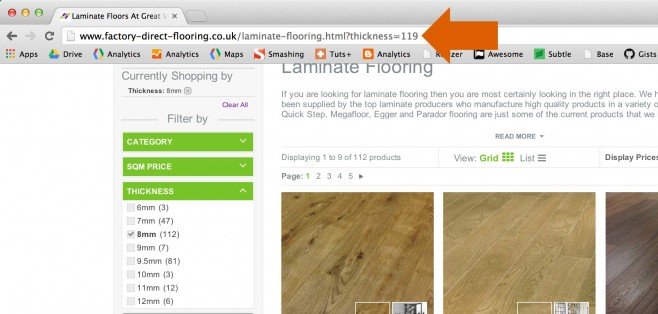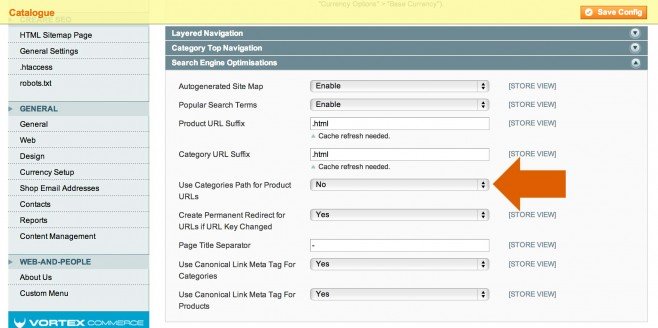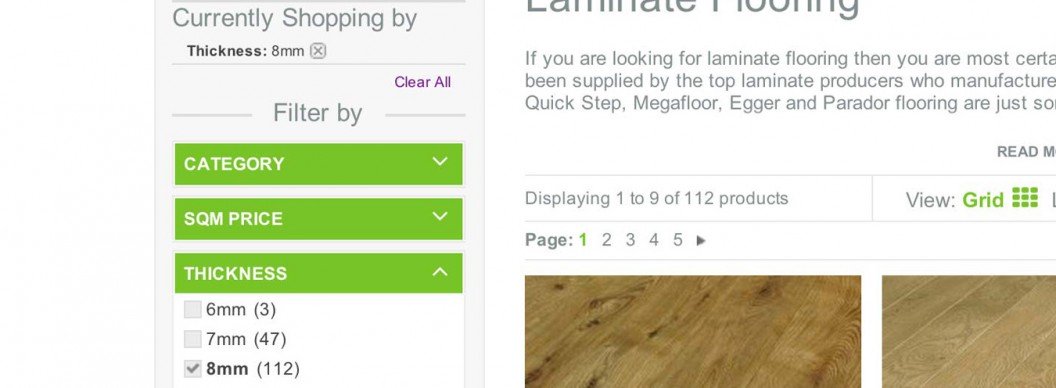I’ve been ecommerce SEO account manager here at Creare now for almost a year, and in this time I’ve faced, tackled and learnt more about onsite SEO than ever before. Ecommerce websites provide a unique challenge in the field of onsite SEO due to their sheer size, and Magento is no different. One small error in coding, or an incorrect configuration, is magnified.
In this article I want to discuss what I believe is the number 1 culprit of non-performing ecommerce websites – internal duplicate content. Internal duplicate content can come in many forms, and I’m really only going to scratch the surface here, but what I will be discussing and proposing solutions to are what I believe to be the biggest offenders when set up incorrectly. They are;
- Layered Navigation
- Product Page URL Configuration
- Duplicated Product Page Content
- Unique Product Page URL Key
1. Layered Navigation
Magento by default creates dynamic pages on category/sub category pages when you filter a page of products by a certain attribute. For example, if you filter by price to display the cheapest products first, or filter by distance of those closest to you.
When you complete this action all the platform is doing essentially is reordering the products on the page in front of you. It’s not adding anything new, well not anything new content-wise anyway. However, Magento creates a new URL with a query string parameter appended:

As you can imagine, we do not want Google to index these variations of the original URL, as they are in essence duplicates. So we want to prevent Google from indexing these pages. There are several different ways of doing this, but I recommend adding the Meta Robots Tag (with noindex,follow) into the head of any parameter based URL. My colleague Rob has written a tutorial on how to do this or you can install our free SEO extension that does this, and much more. I also recommend adding a rel=canonical tag to the header (this tell the search engine what the original page is), though in my experience the canonical tag isn’t always most effective so make sure you have other elements in place to tackle this problem.
(NB. If you are migrating from one ecommerce platform to another make sure that you don’t automatically noindex any URL’s that generate traffic for you. This can be particularly hazardous, and you need to ensure all redirects are created for URL’s that the search engines are displaying.)
2. Product Page URL Configuration
Magento by default (you’ll hear me use this phrase a lot) configures product page URL’s as follows;
www.example.com/category/product
Fine right? Well not really, no. Because you will also have the following URL for every product as well;
www.example.com/product
This is called a top level product URL. Every product will be located on the top level, as you have the functionality to place products in multiple categories. The issue we have here with your site configured as above is that Google has two URL’s to index that contain the exact same content. Alas, it leads to internal duplicate issues. The most simple resolution to this is to ensure the site is built and launched with only top level product URL’s (you can do this by going to System – Configuration – Catalogue – Search Engine Optimisations – selecting ‘No’ in Use Categories Path for Product URLs):

This feature is also available if you download and install our free Magento SEO Extension. This plug in will automatically create 301 redirects from www.example.com/category/product to www.example.com/product. Therefore any remnants of your old product URL structure, whether that be via external links you’ve built or what is still in Google’s old index, will be removed. A quick tip to see if the above is an issue is to look at the Duplicate Meta Description and Duplicate Page Titles area of WMT. If Google is indexing both the top level and category level paths of a single product Google will highlight these here.
3. Duplicated Product Page Content
This is definitely not an area restricted to Magento, and anyone who works with ecommerce website will know the pain and time-consuming issue of product description creation. With websites regularly having thousands of products, the temptation to reuse content from product to product can be very tempting.
However such practice can be hugely damaging to an SEO campaign. Product pages make up 80-90% of a total websites index, and if those 80-90% have duplicate content, that is a huge amount of your site that Google could deem as poor quality.
(NB: I’m only tackling here the potential of internal duplicate content, not the potentially bigger issue of externally duplicated content. If you know this is also an area of concern I strongly recommend you watch this Whiteboard Friday video from the guys at Moz).
4. Unique Product URL Rewrites:
Last, but not least, I want to raise another internal duplicate content issue that seems to be Magento-specific. I’m not aware of this ‘condition’ on any other platform, but that doesn’t mean it might not be a problem. Magento has a habit of adding a series of numbers, usually four for product pages, to the end of URL’s if you have not designated a unique URL key. This is easiest to explain via an example. Let’s say you create the following product;
www.example.com/product
Then you create a similar product, and pretend you use the same URL key. Magento will then automatically (without even asking!) add a series of numbers to the end of the new pages URL key to differentiate this new product from the original. Something like;
www.example.com/product-1234
In my experience there are two main processes in which this can happen. First is by using the ‘Duplicate’ function in Magento that allows you create a replica of any product. This is handy if you have similar variations of a single product and you want to create simple products of them all (rather than one configurable). If you do not amend the URL key field of the new product then Magento will append the series of numbers.
The second way I see this done a lot is when a CSV product upload is used and unique content is not included that will create unique URL keys for each product. This can be a real problem, and there is no real quick fix other than identifying the size of the issue and working through them manually. To ensure this does not happen educate all those involved in adding products to understand the potential issues that can come about if unique content is not prioritised.
(NB. The incredible SEO plugin created by the wizards here at Creare helps to
solve the above by including the option to remove the ‘duplicate’ button and also enforcing unique meta data and product description and short description fields)
Conclusion and Resources
There are many other duplicate content landmines involved in ecommerce and I have only scratched the surface. The above issues I would most definitely check now on your existing sites if you haven’t already. As I said previously, the above issues per se are not hugely damaging and on small websites fixing them would be a matter of good practice. However, take a website with thousands of pages and suddenly you can have a problem.
Before I leave I just want to share some resources that I hope will be of help to you;
My colleague Rob Kent recently published a fantastic book called Magento Search Engine Optimisation. Don’t be misled by the fairly generic title, this book is packed full of Magento ecommerce tips and tricks and covers pretty much every topic you could wish to discuss in fantastic detail.
Finally if you have a passion for ecommerce SEO, particularly Magento, then have a read of Paul Roger’s blog. I’ve only recently discovered this resource but it’s packed with great content.
